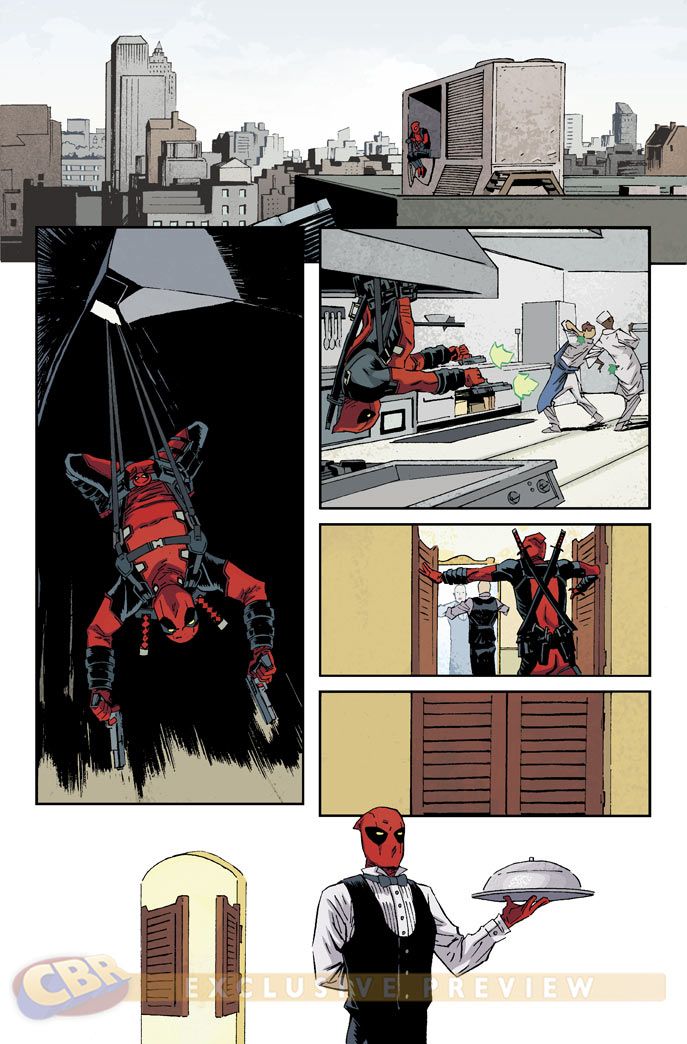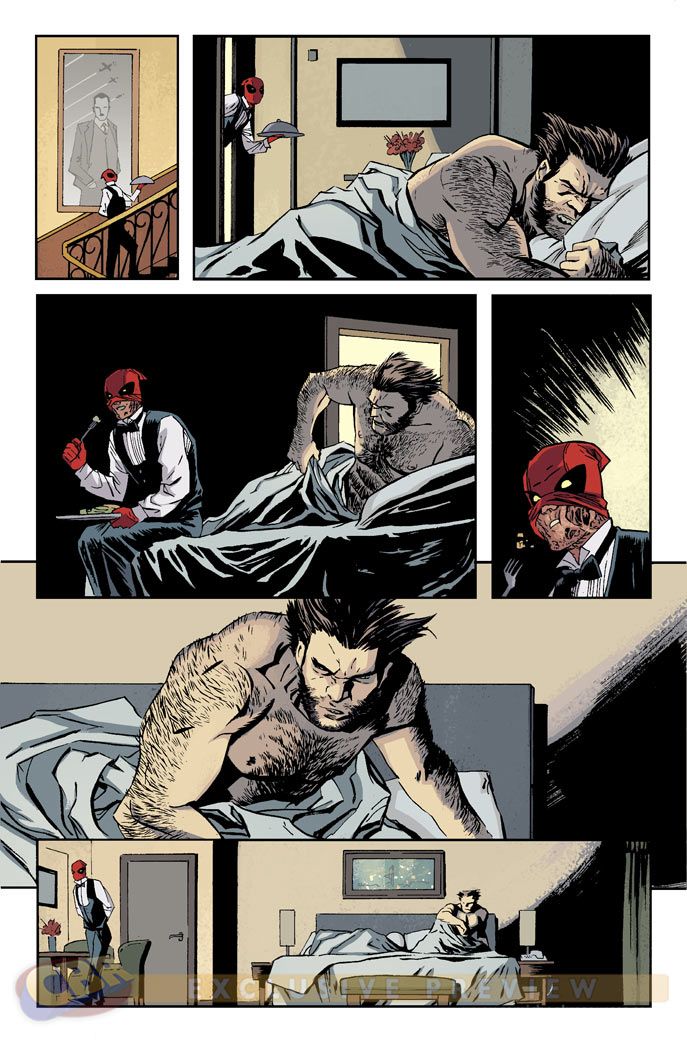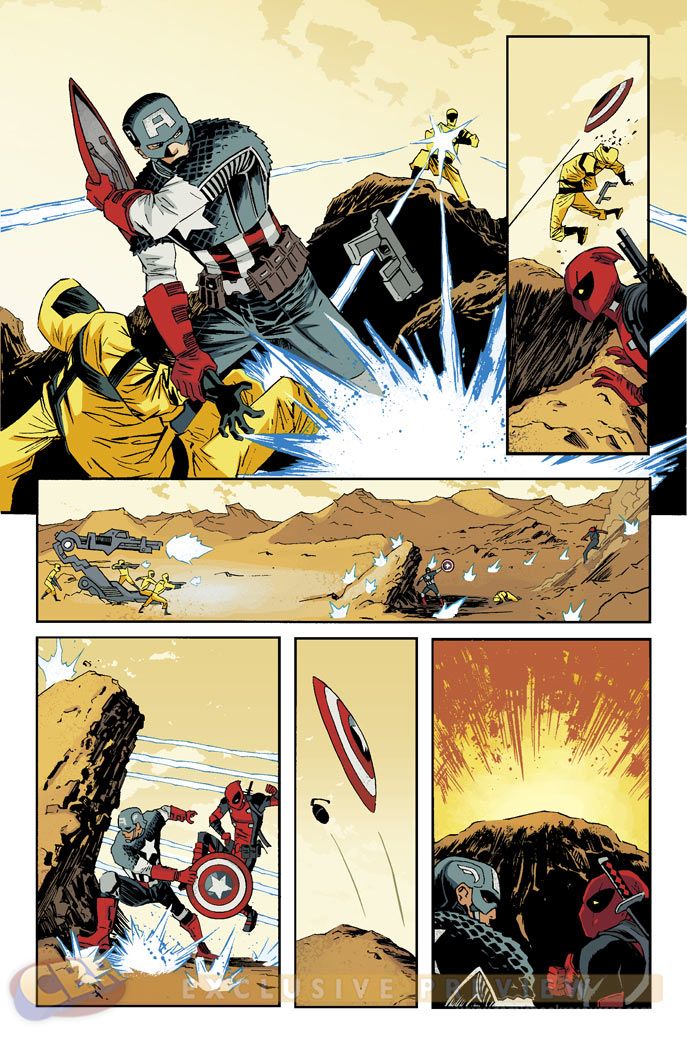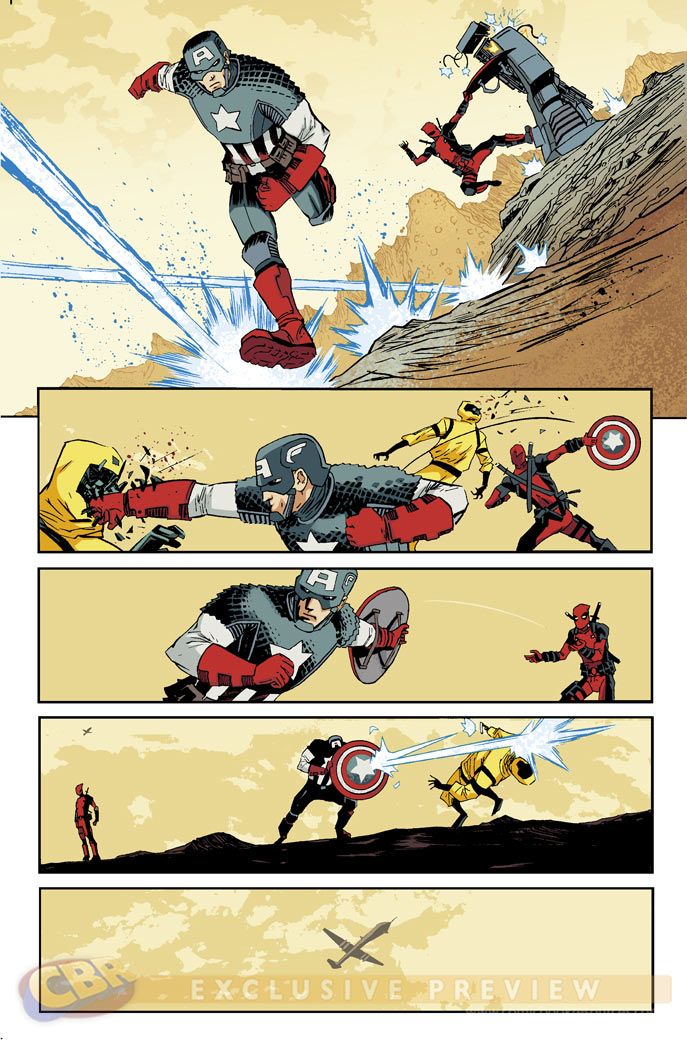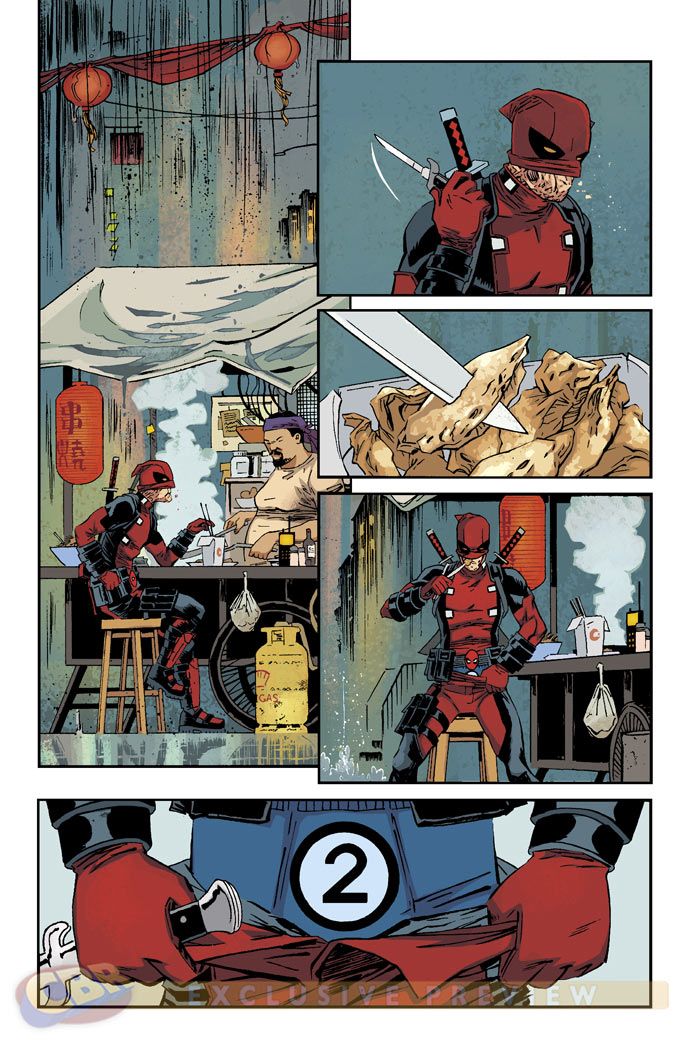Marvel Comics' Deadpool is infamous for his obnoxious motor mouth and a healing factor that allows him to survive even the most mortal of wounds -- but that doesn't mean Wade doesn't feel physical or emotional pain. Later this month, writers Gerry Duggan and Brian Posehn and artist Declan Shalvey kick off new arc "The Good, the Bad, & the Ugly" in "Deadpool" #15, where the Merc with a Mouth will endure copious amounts of both types of pain. He won't have to endure that punishment alone -- much to their chagrin, Captain America and Wolverine will fight alongside Wade, assisting his efforts to expose and a destroy a secret conspiracy with connections to all of their pasts.
CBR News spoke with Duggan and Shalvey about the arc and the story that preceded it which teamed Deadpool with the past and present day incarnations of Luke Cage & Iron Fist.
CBR News: Gerry, let's start with the most recent arc of "Deadpool," which featured an amusing villain named White Man. How did this character come about?
Gerry Duggan: It all goes back to "Deadpool" #7 where Brian and I had some funny ideas for a period comic book, and Jordan D. White, our editor had wanted to try an inventory issue. We had so much fun on that issue that we wanted to start doing them in between bigger arcs, but we also wanted to be somewhat clever and use them to introduce a threat that carries over into the next "main" arc of the book. We wanted to make them feel like less of a stand-alone issue, but I have found that a lot of people used issue #7 as a jumping on point for our run on "Deadpool." I was thrilled about that too.
The most recent inventory issue of "Deadpool" featured a flashback to the '70s and a villain named The White Man.
Those issues are a nice way to flex some other muscles and play in a satirical way with some of the older elements of the Marvel Universe. Hopefully they're a real love letter to those eras as well.
I believe the White Man was an idea from Scott Koblish, our regular "irregular" "Deadpool" artist. He thought if we were going to do a Blaxploitation style story, and we were positive that was going to happen with Deadpool, Power Man and Iron Fist in the '70s, that it would be funny if our villain's name was the White Man. We laughed our asses off, and we don't try to over think things either. If everyone laughs, it's a good idea, and we can make some hay out of it we go for it. Marvel has really been wonderful about letting us tell the stories we want with Deadpool. Plus it seems like most people are pretty happy with the book. So we were thrilled.
Then as you know, the White Man made his debut in issue #13 where you saw him in the Marvel Universe of the '70s and in issue #14 he entered the Marvel NOW! Era.
It was interesting to see the reluctant team up between Deadpool, Power Man and Iron Fist play out in two different eras in those issues. From your past issues, it seems like there really aren't many Marvel heroes who want to encounter -- let alone team up with -- Deadpool.
Duggan: The corner stone of Brian's and my take on how Deadpool relates to people is that most people don't want to have that Marvel team up with him. They would prefer it to happen quickly and quietly with the least amount of eyes on them. That's fun and gives us an opportunity for a lot of comedy, but the book shifted in tone as we moved from #13, which is pretty much a pure piece of comedy writing, to #14, where by the end of the issue we're going in a new direction. I don't want to spoil the issue for those who haven't read it yet, but it does lead directly into "The Good, the Bad, & the Ugly." Hopefully, you'll laugh a lot in issue #14 and then the end of the issue will leave you saying, "Whoa! That happened quickly!" [Laughs]
Issue #14 was actually a bit of a happy accident. We needed another issue to make sure that Declan could get enough time to get ahead on "The Good, the Bad, & the Ugly." So it ended up being an unexpected treat to have Scott do two issues back to back; one a throwback and one a Marvel NOW!
Hopefully, #14 felt like it was always designed to be the follow up to #13, but to us it was more an interesting opportunity that arose. So In order to make sure "The Good, the Bad, & the Ugly" shipped uninterrupted we got to continue the White Man saga.
Let's back up a little bit to the revelations about Deadpool's memory that came at the end of issue #12. Those revelations showed that Wade has actively chosen not to reflect on what happened to him when he washed out of the Weapon Plus Program. What's your sense of what happened to Wade during and after his time in that program? How do you feel that impacted him?
Duggan: Yes, the events of "The Good, the Bad, & the Ugly" do deal with an opportunistic doctor and a program that used the advances from the Weapon Plus Program. The happy accident that was Wade was commercialized. We've seen him be bagged and tagged and we've alluded to this happening throughout his life. Now we'll find out what was exactly was happening and why.
"The Good, the Bad, & and the Ugly" is an important "Deadpool" story that could have a large impact on the Marvel Universe. If Deadpool can't find a way to shut down what's going on in this story, it could have major consequences. Also it's a really fun excuse to have Cap and Wolverine in the book. The thing that they all have in common is that they're all super soldiers, and what's been happening to Wade will directly affect their lives too.
Declan, Deadpool, Captain America and Wolverine are not the first costumed super soldiers you've drawn. You also drawn tales featuring super powered and costumed military men like Venom and Crossbones. Is that more of a happy coincidence, or is there something you find especially exciting about these types of characters?
Declan Shalvey: It must be a happy coincidence, as I never ask for these characters, yet they are characters I end up drawing and also I really enjoy drawing. I think I prefer the more street-level, grounded characters in the Marvel U. They play to my strengths of drawing atmospheric stories with more grounded, 'realistic' characters, but it also gives me the opportunity to inject the visual spectacle that comes with Marvel superheroes. Crossbones, Venom and now characters like Deadpool and Wolverine definitely give me the chance to do some of my best work. I can draw an exciting action packed story, yet also get the opportunity to do some moody storytelling.
Can you talk a little more about the dynamic between Deadpool, Cap, and Wolverine? Over in Rick Remender's "Uncanny Avengers," Cap recently discovered the activities of Wolverine's X-Force, which Wade was a part of. Will Cap's feelings about X-Force factor into or inform the interactions between the three characters?
Duggan: Yes, for sure. It's another very good reason why Captain America would not want to be seen lending the flag to their sort of activities. Rick's run on "Uncanny X-Force" was a really fun and a tremendous story that is still impacting the Marvel Universe.
There's an event in this story that causes Captain America to feel that this isn't a job for the Avengers, but he has to get involved. Cap will stay to fight this one through because there are a lot of innocent lives that are being ground up in the gears of this plot that Wade is a central figure in. So Cap will feel duty bound to get involved.
Then, Wolverine spent a lot of his life as a lab rat. To see Wade go through that gets Logan's Irish up
Does that mean there's a sense of camaraderie between Logan and Wade given what they went through as part of the Weapon Plus Program and from their time as teammates in X-Force?
Duggan: Absolutely, and there are some difficult times for Wade in this next arc that would make even the coldest heart sort of turn for Wade. He'll bleed in a way that he hasn't really bled. For a guy who doesn't have a whole lot of friends, it would be very difficult for Steve Rogers and Logan as human beings to not want to support him coming out of it.
Declan, the last time we spoke, you mentioned there was a moment of vulnerability in the first issue that gave you a way into Deadpool's psyche and the story you're drawing. It sounds like this will be a very painful story for Wade Wilson to a certain degree. What's it like drawing an emotionally tormented and vulnerable Deadpool? How does such a manic and energetic character carry himself and move when he's feeling sorrow and anguish?
Shalvey: Well, when we start this story Deadpool is his usual regular(ish) self. As it goes along it gets more intense, but what I liked about this story was that Wade has had enough. He's been messed with, jerked around and abused for who knows how long and now he wants some answers. That determination is what got me interested in the story and provided real momentum. If anything, it just makes Deadpool a little more resolute. He's still a nutter, but a nutter with purpose, so he carries himself in a much more motivated way.
Yes, I did mention that there was a scene in the first issue that really clicked with me -- it's when the veil of Deadpool is lifted and we see that this character Wade Wilson is actually in pain. The sorrow and anguish, etc. -- that comes later.
This is a darker arc, but it's not without humor. You're not known usually known for your comedic work -- how does it feel to get a chance to do something that's got both a deep emotional core and some solid laughs as well?
Shalvey: It's exactly the type of story I want to be doing. A dark emotional story is great, but unless there's some comedy then it's just torturous to read. Same with a comedy that has no sense of direction or consequence. I feel the best stories are a great balance of drama and comedy, so getting to do that in "Deadpool" is a real treat. I feel like I had some practice in the "Like Lightning" arc of "Thunderbolts," when I wrapped up that series with Jeff Parker. The series had some excellent comedy, but that arc in particular got really heavy, and I found it much more creatively rewarding as a result.
The same can be said for this new arc on "Deadpool." Even though it is a darker story, there are still plenty of laughs. The scripts literally make me laugh out loud.
In terms of tone, "The Good, the Bad & the Ugly" is an action packed, funny, and poignant story. What else can you tell us about the plot?
Duggan: There's a bit of a mystery that I don't want to spoil, but you sort of get hints of it from Declan's cover to issue #16. So there are several things going on in this story. There's a personal plot that's happening directly to Wade, and a sort of grander scope that Wade's tissues and organs were being used as the foundation for.
Declan, that cover for "Deadpool" #16 features several characters that appear to be members of the "Giant Size" #1 era of the X-Men. Was "The Good, the Bad, & the Ugly" a chance for you tackle not just three, but several iconic Marvel characters?
Shalvey: I don't want to give anything away about the second issue, but let's just say I took the opportunity to try and draw some X-Characters I've always wanted to draw. It did give me the chance to play with some different X-type mutants, which I loved doing. I'd love to try my hand at an X-Team book someday, and this arc of Deadpool gave me the opportunity to play with that idea.
Let's move onto the villain of "The Good, the Bad, & the Ugly." What can you tell us about the main antagonist of this arc? What made this character a good foil for Deadpool, Cap & Wolverine?
Duggan: Our main antagonist in "The Good, the Bad, & the Ugly" is a doctor named Butler who doesn't have any super powers and his evil is really very banal. That's what I like about him. He's there to make a buck. There's a personal agenda, but he's got bosses and is doing work for hire. It's a program that would be bad news if it were unveiled.
Declan, what's your take on Butler? Which aspects of his personality did you want to capture and bring forward in your art?
Shalvey: Butler is a complete scumbag, basically. Wade wants him dead. Though we do understand his motivations to a degree, the methods he uses to achieve them are deplorable. Still though, I wanted him to be sharp; he's very smartly dressed and he carries himself in a very refined and confident way. I was thinking of Patrick Stewart and Bryan Cranston when drawing him; older gentlemen who have a great dignified presence.
One thing I really wanted to do though is a proper take on Deadpool, Cap and Logan. I wanted to make sure that no one could mistake one for the other. Wolvie's body type should be completely different to Cap's and his to Deadpool's etc. I also wanted to draw Deadpool a little differently to how he's been drawn of late. I wanted him to have an edge; so I tweaked the black shapes on his eyes, made him leaner and less bulky, etc. I really wanted to emphasize the stealthy ninja aspect of the character, rather than the muscle-bound Arnie type.
Just how dangerous is Butler? You mentioned he has no super powers and in "The Good, the Bad, & the Ugly" he's up against three of the Marvel Universe's toughest super soldiers. How cunning is Butler? What kind deadly resources are at his disposal?
Duggan: As I explained earlier, if there's a threat of a Deadpool team-up most people would try to wiggle out of it and Cap and Wolverine are no different. However, after initially spurning Deadpool's requests for help the fight is more or less taken to them.
That fight and the threat emerges because Butler is working with a nation state with interest in acquiring their own super soldiers. The arms race in the Marvel Universe is less about nukes and more about what you can do with some of the DNA that is floating out there, like weaponizing heroes. So they have made advances and there will be some really fun bad guys for the three characters to take on.
Since "The Good, the Bad, & the Ugly" is a story tied into Deadpool, Cap and Wolverine's pasts as experiment subjects, is this a story that takes place entirely in the present, or will there be flashback sequences to your main characters' pasts?
Duggan: There will be flashback sequences but not as many as you would think, and probably not flashing back to what you would expect. We use one at the top of each of the first three books for each of the characters, the good, the bad, and the ugly. They root this character in the story and show why it's important to them and why they have to finish this instead of immediately heading back to the Avengers mansion.
Everyone is invested and that's how we use those flashbacks, which has been fun too. We're going to different eras in those three flashbacks.
Declan, what was it like drawing those scenes? Did they afford you the chance to temporarily change up the look or the feel of the story?
Shalvey: I loved drawing the flashback sequences; it was great to do a little one-page nod to the history of each character. When I drew the first flashback in #15, I was thinking that Jordie [Bellaire, "Deadpool" colorist] would try something a little stylized to break it up from the rest of the story. As the arc progressed, we saw there were more flashbacks, and Jordie come up with the idea of using the same color scheme for each flashback, unifying the approach for the whole arc and visually tying all the characters together. It worked out really well and they're some of my favorite pages as a result.
"Deadpool" #16 teases the appearance of some the X-Men's classic roster.
The flashbacks and Deadpool running afoul of Butler, who's been using him as a guinea pig for several years, means Deadpool will have to confront several painful elements of his past. Confronting the past can often be a transformative experience. What kind of impact will that have on Wade Wilson?
Duggan: The hope is that by the end of "The Good, the Bad, & the Ugly," Deadpool might be given a little bit of a fresh slate in terms of how he might be seen. He is a guy whose moral compass has been spinning and to a certain extent we want to be able to show you why that is.
That means "The Good, the Bad, & the Ugly" is not a retcon, but we're attempting to do a unified theory of Deadpool's various origins. There's the origin where he's from Ohio and there's one where he's Canadian. There's different ways that he remembers things and Butler and his program is the reason why Wade is very confused. He's an important guy in Wade's life who's only just being revealed, and we want to do this in a way where we're not invalidating a single moment of any "Deadpool" issue you have read.
We're trying to show you where everything fits in the mosaic. Wade will learn something about himself without spoiling who he is. It's a real tight rope for us to walk, but I think we've done it, and we did it with the perfect team. Declan and Jordie have just been tremendous together.
What can readers expect from this arc from an artistic standpoint?
Duggan: They've got a really great sense of style for this. Jordie's palette on top of Declan's dark stuff has has been fantastic.
Plus, Declan's ability to deliver a really great laugh is going to be a nice surprise for some people. He's got such a fluid, dynamic style that the action leaps off every page, and when we need to stop and have a conversation to slow things down those pages are great too.
Jordie and Declan are perfect together and I think even though there are fewer jokes than have been in previous issues there are still some pretty big laughs. I've been a huge fan of Declan's work so we were super thrilled that we could steal him from "Venom." [Laughs]
Shalvey: I definitely wanted this arc to be a lot moodier. I can't help but try to add mood and atmosphere to a story! It has a lot of gritty techniques that I use but I also have the great opportunity to work with Jordie on this series. We've been collaborating on covers for the past year or so, and now that we're getting to collaborate on a sequential story, we've had great talks about the look of the story and how to approach each scene.
Jordie on any job brings an excellent sense of color design; a thoughtful approach of using color to tell a story. Her suggestions inform and improve the art and she has an uncanny ability to make every book she does look GREAT. I gave Jordie the space to do what she wanted on this book and she delivered in spades. The book is just as moody as I was hoping for and when it needs to go up a gear she made those moments sing. I could not be happier with what she did on this book. We work in the same studio space so I feel it's been a really collaborative experience. I hope that shows in the final artwork.
"The Good, the Bad, & the Ugly" is five parts. Will the conclusion of that story close out the year for "Deadpool?"
Duggan: I believe the last issue of "The Good, the Bad, & the Ugly" is "Deadpool" #19. That technically is our first year. It feels really good to close out our first year with this story.
I think no matter what your favorite Deadpool is, we sort of hit on it in our first year. When you sit back and look at things, you've seen a couple of different Deadpools and this is him emerging much more as a curious figure. Butler was sort of a pot that Wade was planted in and once he's out of that smaller pot he'll have an opportunity to grow. He'll still be the same character that you love, but if he's successful in this story he won't be a victim of these horrible medical experiments and that would have an impact on him. It will be a time for him to grow as a person. He may not know for sure where he's going. [Laughs] But he will be going somewhere.
I also think that anyone who has been along for the ride will sort of see a new gear from us in "The Good, the Bad, & the Ugly." If you're a Captain America fan or a Wolverine fan who has not been reading "Deadpool," I think it's a really good opportunity to see how much Brian and I love these characters. I got such a thrill out of writing really cool moments for the three of them that aren't just action scenes. There are great character beats for them as well.
There's something for everyone in those five issues and I'm so excited for people to finally get to see what we've been working on. Sometimes, I'm many months ahead on a double shipping book. I'm really looking forward to the fall because I think and hope that "Deadpool" readers will enjoy this, and if you have not been a Deadpool fan I think this story has a real shot to make you one. We're telling it to have fun, but I think while we're here we're not just writing comedy stories. I think this will be an important one in the grand scheme of things.
Shalvey: This new arc of Deadpool has been a blast to work on. I feel I've gotten to do some of my best work to date drawing characters that I love and I worked with one of the best colorists in the industry on an excellently entertaining story by Gerry and Brian. This story has drama, action, great characters and is visually engaging and interesting. I hope you all enjoy it.
"Deadpool" #15 hits stores August 28.



